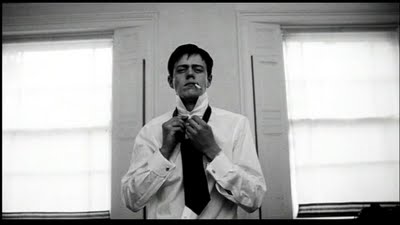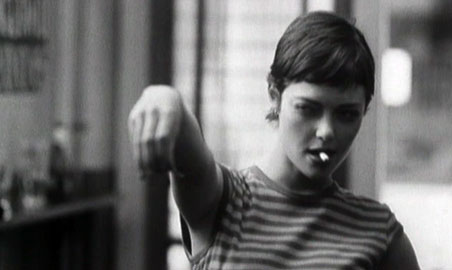Tristan is a guy who wishes to be more like the movie characters he idolizes. However, rather than trying to mimic the styles of contemporary mainstream superstars such as Will Smith, Johnny Depp, or Natalie Portman, Tristan chooses to embrace the behaviour and groove of Jean Paul Belmondo from Jean-Luc Godard’s classic film Breathless. The difference between most fans and Tristan though is that he fully submerses himself in this character. He’s got the style, the slang, and the pretension; the only piece he’s missing is the girl.
Fans and those familiar with Godard’s Breathless will no doubt notice the several references to the classic film. Beyond the similarities in the protagonist’s persona is also the use of jump cuts, the bold romantic visuals, the up-beat music, and of course, the girl, Zazie, who directly resembles Jean Seberg (who plays Patricia in Breathless). In essence, the short puts us into the French New Wave through the eyes of one of its biggest admirers.
The short does a great job of combining both homage to and parody of Godard’s Breathless and the result is something that has a lot of fun with its characters, dialogue, and style. There is much parody and humor in the fact that Tristan, a British guy, who idolizes the American actor John Wayne, but is imitating a French character who in turn emulates an American Hollywood star, Humphrey Bogart. There is also much parody in how the first half of the short plays off the pretentiousness of Tristan and, in a sense, that the pretentiousness of Godard’s classic. Before this becomes slander though, the short takes a turn to fully and sincerely embrace a romantic relationship similar to the one in Breathless. The parody becomes homage not only to what Godard achieved stylistically, but also to the unique and conflicted relationship he was able to create between Michel (Belmondo) and Patricia (Seberg).
Not only is Tristan searching to complete the character he has devoted himself to, but, as we see from the opening frames, he’s also looking for his dream girl. The other struggles Tristan faces come from the constant reminders of, and ties to, his former self. When he’s looking in the mirror, getting into character, his mother phones and interrupts him with a reminder that he has to take his little sister to the cinemas (a scene which has tempted me to create my own John Wayne voice mail message). Tristan is then forced to find a balance between the character he has created for himself and reality. As luck would have it though, it is this trip to the theatre where he not only finds his dream girl, but also finds a girl who shares his taste in film (an important ingredient for all healthy relationships). In keeping with the style of his idol, he attempts to impress her with overly dramatic knock-out punches and foosball.
As we see however, their relationship becomes much more than that. Zazie completes the character Tristan aspires to be, but more importantly she fulfills the key role the real Tristan has been looking for (as he puts it, with her he’s no longer a “fool”). These characters find the best in themselves in recreating a relationship that they perceive is beautiful. They fall in love with one another through film references and, as a result, act more cinematic and playful. By mimicking movie characters, they are more prone to act on their desires and impulses. They don’t let a moment pass by and seize every opportunity that comes their way. In distancing themselves from who they are externally, they readily act on what they feel internally and discover who their true selves are. Tristan and Zazie learn how to become lovers through homage.
This is the first film by director Toby MacDonald. The short has been screened at several film festivals, including the BAFTA’s, and has received numerous awards.
Jon Dewar is a grad student at University of New Brunswick, Fredericton and is working towards a degree in education. He is an avid film fan, interested in both film analysis and filmmaking. Some of his inspirations include directors such as Paul Thomas Anderson, Steve McQueen, and Martin Scorsese. Jon has written numerous screenplays and is working towards eventually producing some of these projects.




Absolutely terrific movie. First thoughts. 1) It’s kind of the story of my life. 2) I love movies in which people are gratuitously cruel to innocent children. 3) I have that problem when I tie my tie.
Thanks, Jon, Welcome to NC.
Great film and thanks for the intro Jon. Welcome to NC!